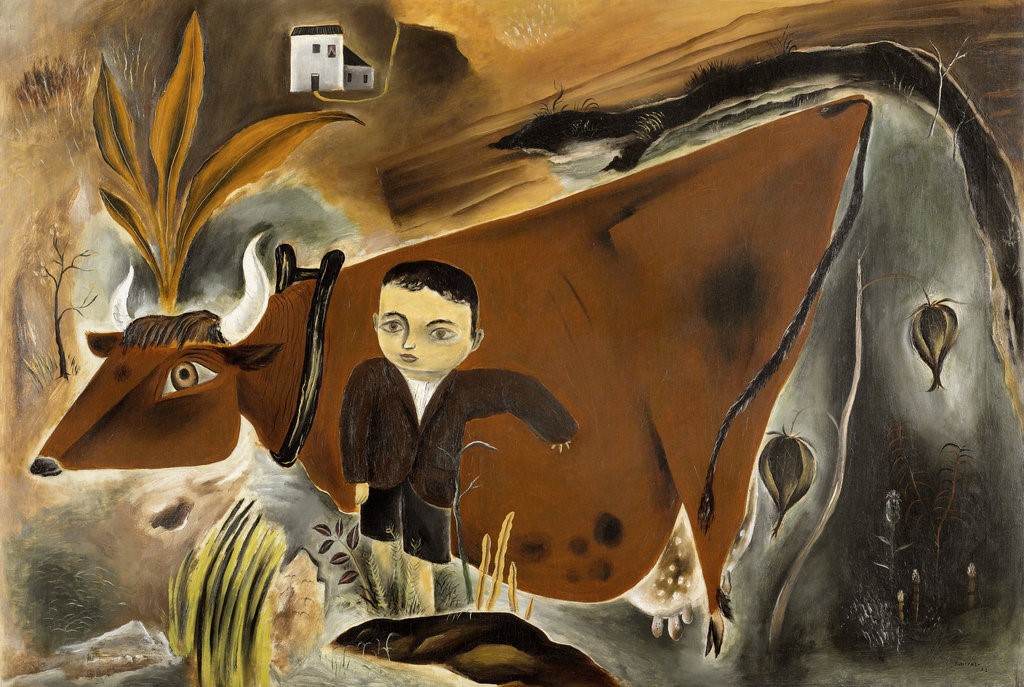
Yasuo Kuniyoshi, Little Joe with Cow, 1923. 28 x 42 in. Crystal Bridges Museum of American Art, Bentonville, Arkansas, 2010.108.
In this blog series, the Crystal Bridges Curatorial team explores stories of American art paired with archival photographs courtesy of the Archives of American Art (AAA), Smithsonian Institution. In this post, Associate Curator Jen Padgett examines the importance of advocating for artists through the work of artist Yasuo Kuniyoshi and his efforts in leading the Artists Equity Association.
In order for artists to create work, they need support. Art often addresses ambitious concepts and inspires the imagination, but behind all of it, artists face the economic realities of the world like everyone else, especially in our current COVID-19 reality.
Artist Yasuo Kuniyoshi understood the economic challenges of this path. While he enjoyed acclaim and critical success, he saw the importance of joining forces with other artists to advocate for their collective benefit.
Leading the Artists Equity Association
In 1947, Kuniyoshi became the first president of the Artists Equity Association. The new organization—which continues to exist today—was founded by a group of artists who desired greater mutual support in their field.

Alexander Archer. Artists Equity Dinner in honor of Yasuo Kuniyoshi, 1948 March 25. Yasuo Kuniyoshi papers, 1906-2016. Archives of American Art, Smithsonian Institution.
In a letter soliciting memberships, Kuniyoshi explained there had previously been no organization in the United States that “represents and speaks for the economic interests of the painter, the sculptor and the graphic artists.” His letter continued to outline how the Artists Equity Association would advocate for artists by encouraging patronage, promoting favorable government legislation, and even establishing “a welfare fund and other social security benefits,” among other initiatives.
These efforts resonate with growing calls to support artists today, as many people become increasingly aware of how the global COVID-19 pandemic has impacted the careers and incomes of creative professionals.
The letter sent by Kuniyoshi (below) can be found in the Archives of American Art, Smithsonian Institution, within the Downtown Gallery records. The Downtown Gallery represented Kuniyoshi’s work. Its founder, Edith Halpert, had a close relationship with him for decades. Halpert was a tireless promoter of living American artists. Numerous letters in the archives between Halpert and “Yas” (as he was known to friends) reveal the depth of their personal and professional connection.


Artists Equity Association Letter (Downtown Gallery records, Reel 5548, box 24, frames 1101 and 1102, Kuniyoshi, Yasuo, undated 1932-1940)
Kuniyoshi’s Little Joe with Cow

Yasuo Kuniyoshi presented with a cow (created by puppeteer Bil Baird) by members of the Artists Equity Association, at the 1948 dinner in his honor. Yasuo Kuniyoshi papers, 1906-2016. Archives of American Art, Smithsonian Institution.
The painting Little Joe with Cow in the Crystal Bridges collection has a special place in the story of Halpert and Kuniyoshi. Little Joe with Cow was part of Edith Halpert’s private collection until her death in 1970. In an exhibition at the Jewish Museum last year, the painting was reunited with other works she personally owned. The object’s history speaks to the connection between the two and Halpert’s appreciation for the artist’s imaginative vision.
Together, this individual relationship and Kuniyoshi’s leadership with the Artists Equity Association demonstrate the personal and professional support crucial to the creative work of artists.

Kuniyoshi’s Little Joe with Cow is currently on view in the Modern Art Gallery at Crystal Bridges. Photo by Ironside Photography / Stephen Ironside.
Special thanks to the Archives of American Art, Smithsonian Institution for sharing their photographs.
This post was written by Jen Padgett, associate curator, Crystal Bridges.



